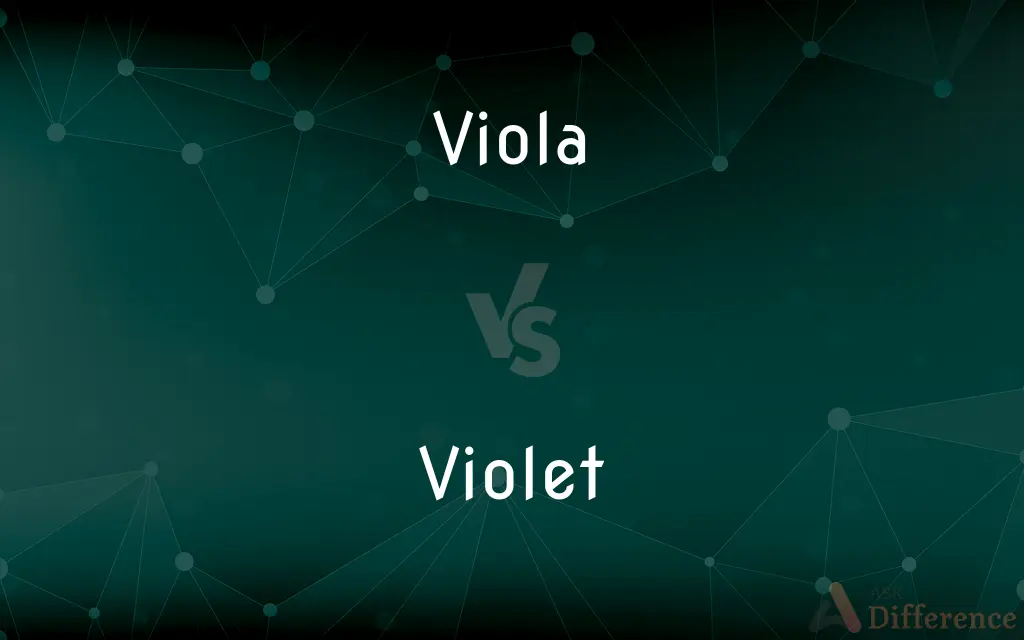Viola vs. Violet — What's the Difference?
By Tayyaba Rehman & Maham Liaqat — Updated on April 21, 2024
The viola is a stringed musical instrument slightly larger than a violin, while a violet is a small flowering plant known for its purple blooms.

Difference Between Viola and Violet
Table of Contents
ADVERTISEMENT
Key Differences
The viola is known for its rich, deep sound, which is slightly lower than the violin due to its larger size and thicker strings. Whereas, the violet is recognized for its vibrant purple flowers and is commonly found in gardens and wild areas.
Violas are crucial in orchestras and chamber music for adding depth to the ensemble's sound, playing in the alto range. On the other hand, violets contribute to biodiversity, offering aesthetic beauty and sometimes medicinal properties.
The construction of a viola involves specialized craftsmanship, with materials like spruce and maple commonly used to enhance its unique sound. In contrast, violets are herbaceous plants, growing from seeds and often spreading through rhizomes.
Viola players need years of practice to master the instrument, focusing on techniques specific to its size and sound production. Conversely, violets require minimal care, thriving in various climates and soil types, making them popular among gardeners of all skill levels.
While the viola is primarily used in classical music, its versatility allows it to be included in folk and contemporary genres. Violets, however, are often used in perfumes and cosmetics, prized for their fragrance and essence.
ADVERTISEMENT
Comparison Chart
Type
Stringed musical instrument.
Flowering plant.
Role in its Field
Adds depth to musical compositions.
Adds aesthetic and biodiversity to gardens.
Construction/Materials
Made from woods like spruce and maple.
Grows from seeds, often spreading by rhizomes.
Usage
Used in orchestras, chamber music, and more.
Used in gardening, perfumes, and cosmetics.
Care and Maintenance
Requires regular tuning and skilled play.
Requires minimal care, adaptable to many environments.
Compare with Definitions
Viola
A bowed string instrument larger than a violin with a deeper sound.
She played the viola beautifully, filling the room with warm, rich tones.
Violet
A small flowering plant with distinctive purple flowers, common in temperate regions.
The forest floor was carpeted with wild violets.
Viola
A musical instrument played using a bow, held vertically between the chin and the shoulder.
He switched from violin to viola because he preferred its deeper sound.
Violet
Belonging to the genus Viola, including a variety of species with different colors.
The garden variety of violet is hardy and blooms early in spring.
Viola
An instrument in the violin family tuned a fifth below the violin.
The viola's unique timbre is crucial in orchestral settings.
Violet
Known for its ornamental and medicinal values.
Violets have been used traditionally to treat various ailments, from headaches to colds.
Viola
Used primarily in classical music but also in modern music genres.
The composer integrated a solo viola in his latest jazz fusion piece.
Violet
A perennial or annual plant, depending on the species.
She planted perennial violets that bloom every year without fail.
Viola
An alto instrument of the string family, often overshadowed by the violin.
The quartet’s viola section added a superbly melancholic layer to the piece.
Violet
A plant often used in herbal remedies and cosmetics for its fragrance.
Violet extract is a popular ingredient in natural skincare products.
Viola
The viola ( vee-OH-lə, also UK: vy-OH-lə, Italian: [ˈvjɔːla, viˈɔːla]) is a string instrument that is bowed, plucked, or played with varying techniques. It is slightly larger than a violin and has a lower and deeper sound.
Violet
Any of various low-growing herbs of the genus Viola, having short-spurred, irregular flowers that are characteristically purplish-blue but sometimes yellow or white.
Viola
A stringed instrument of the violin family, slightly larger than a violin, tuned a fifth lower, and having a deeper, more sonorous tone.
Violet
Any of several similar plants, such as an African violet.
Viola
An organ stop usually of eight-foot or four-foot pitch yielding stringlike tones.
Violet
The hue at the short-wavelength end of the visible spectrum, evoked in the human observer by radiant energy with wavelengths of approximately 380 to 420 nanometers; any of a group of colors, reddish-blue in hue, that may vary in lightness and saturation.
Viola
Any of various plants of the genus Viola, which includes the violets and pansies, especially certain ornamental varieties that are usually more compact than pansies and have smaller flowers without a blotch on the petals.
Violet
A plant or flower of the genus Viola, especially the fragrant Viola odorata; (inexact) similar-looking plants and flowers.
Viola
(botany) Any of several flowering plants, of the genus Viola, including the violets and pansies.
Violet
(figurative) A person thought to resemble V. odorata, especially in its beauty and delicacy.
Viola
A stringed instrument of the violin family, somewhat larger than a violin, played under the chin, and having a deeper tone.
Violet
A bluish-purple colour resembling that of most V. odorata.
Viola
A person who plays the viola.
Violet
Clothes and (ecclesiastical) vestments of such a colour.
Viola
(music) An organ stop having a similar tone.
Violet
(perfumes) The characteristic scent of V. odorata.
Viola
(music) A 10-string steel-string acoustic guitar, used in Brazilian folk music.
Violet
Syn of onion.
Viola
(music) A berimbau viola, the smallest member of the berimbau used in capoeira music.
Violet
Having a bluish-purple colour.
Viola
A genus of polypetalous herbaceous plants, including all kinds of violets.
Violet
Any plant or flower of the genus Viola, of many species. The violets are generally low, herbaceous plants, and the flowers of many of the species are blue, while others are white or yellow, or of several colors, as the pansy (Viola tricolor).
Viola
An instrument in form and use resembling the violin, but larger, and a fifth lower in compass.
Violet
The color of a violet, or that part of the spectrum farthest from red. It is the most refrangible part of the spectrum.
Viola
Any of the numerous plants of the genus Viola
Violet
In art, a color produced by a combination of red and blue in equal proportions; a bluish purple color.
Viola
Large genus of flowering herbs of temperate regions
Violet
Any one of numerous species of small violet-colored butterflies belonging to Lycæna, or Rusticus, and allied genera.
Viola
A bowed stringed instrument slightly larger than a violin, tuned a fifth lower
Violet
Dark blue, inclining to red; bluish purple; having a color produced by red and blue combined.
Violet
Any of numerous low-growing small-flowered violas
Violet
A variable color that lies beyond blue in the spectrum
Violet
Of a color midway between red and blue
Common Curiosities
How do you grow violets?
Violets thrive in light shade with moderate watering and can grow in a variety of soil types.
How do you care for a viola?
Regular tuning, proper storage, and skilled playing are essential for maintaining a viola.
Can violets be used for anything other than decoration?
Yes, violets are used in perfumes, cosmetics, and traditional herbal remedies.
What is a violet?
A violet is a small flowering plant, typically with purple flowers, belonging to the genus Viola.
What's the difference in sound between a viola and a violin?
The viola has a deeper, richer sound than the violin due to its larger size and lower tuning.
Are violets edible?
Yes, certain species of violets are edible and are sometimes used in salads and desserts.
How does the viola contribute to an orchestra?
The viola provides depth and warmth to the orchestra's sound, playing in the alto clef.
Can violets grow indoors?
Yes, with proper light and care, violets can thrive indoors.
What is a viola?
A viola is a stringed musical instrument, larger than a violin, known for its deep, rich sound.
What types of music use the viola?
The viola is used in classical, chamber, folk, and some contemporary music genres.
Are violets easy to maintain?
Yes, violets are relatively easy to care for and can adapt to various environments.
What colors do violets come in?
While commonly purple, violets also come in white, blue, and even yellow varieties.
What is the historical significance of the viola?
The viola has been an integral part of Western classical music since the Renaissance, valued for its rich tone.
Do violets have a scent?
Yes, many violet species are known for their sweet floral scent, highly valued in perfumery.
Is the viola harder to play than the violin?
The viola requires different techniques due to its size and sound, which some may find more challenging.
Share Your Discovery

Previous Comparison
Electrometer vs. Voltmeter
Next Comparison
Graduation vs. CulminationAuthor Spotlight
Written by
Tayyaba RehmanTayyaba Rehman is a distinguished writer, currently serving as a primary contributor to askdifference.com. As a researcher in semantics and etymology, Tayyaba's passion for the complexity of languages and their distinctions has found a perfect home on the platform. Tayyaba delves into the intricacies of language, distinguishing between commonly confused words and phrases, thereby providing clarity for readers worldwide.
Co-written by
Maham Liaqat












































